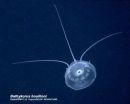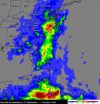(Press-News.org) SEQUIM, Wash. – Most toxic pollution falling onto Puget Sound's waters has decreased – some by as much as 99 percent – below earlier estimates, according to a region-wide study. Despite the overall decline, the study found that industrial areas like Tacoma still have the Puget's Sound's highest air-deposited contamination levels.
The study, by researchers at the Department of Energy's Pacific Northwest National Laboratory and Texas A&M University at Galveston, found the amount of trace metals like arsenic, lead and copper falling onto the Tacoma region have decreased significantly since PNNL last measured air-deposited pollution there in 1991. But other contaminants like mercury showed a more modest decline of just 35 percent.
"Regulations and increased public focus on pollution prevention appear to be paying off," said the study's lead researcher, PNNL marine chemist Jill Brandenberger. "But our awareness of some chemicals wasn't very high when those initial laws were passed decades ago. As a result, chemicals like flame retardants weren't included, allowing them to accumulate in the Puget Sound."
The study is helping the Washington state Department of Ecology update its measurements of all toxic sources for Puget Sound. Gov. Christine Gregoire and the state Legislature charged the Department of Ecology and the Puget Sound Partnership with restoring the Sound, which is burdened with pollutants and other problems. To do that, officials need to know how much and where pollution is entering the Sound. This prompted the Department of Ecology to measure toxics in the entire Puget Sound through projects such as the PNNL-led study.
Trace metals down, Tacoma's industrial area above average
Pollution, unfortunately, doesn't often stay put. It's transported between the land, water and air when nature moves it. One way it moves is through atmospheric deposition, or when pollution falls from the sky and onto the surface of water or land.
To measure air-deposited pollutants throughout the region, researchers placed collection stations at eight sites on the Puget Sound shoreline between August 2008 and October 2009. Equipment at each site collected various types of toxic chemicals falling from the sky along with rain. The collected rain was analyzed at PNNL's Marine Sciences Laboratory in Sequim and by oceanographer Patrick Louchouarn at Texas A&M University at Galveston.
The study shows that about 770 pounds of arsenic, 2,400 pounds of lead and 6,000 pounds of copper are currently deposited onto the Sound annually. That's significantly less than initial estimates that the Department of Ecology developed in 2007 with data from PNNL's previous Tacoma study and a scientific literature review. The initial estimates predicted that 6,800 pounds of arsenic, 68,000 pounds of lead and 68,000 pounds of copper were being deposited onto the Sound each year.
Tacoma, like the rest of the Puget Sound, also experienced an overall decrease in contaminants. But data collected near the Port of Tacoma on Commencement Bay stuck out like a sore thumb, Brandenberger said. That site, on the bay's southwestern end, consistently recorded higher deposition rates than the rest of the Sound. For example, the daily deposition rate of copper and lead was 10 times higher there than any other place measured in Puget Sound.
Researchers reasoned that industrial activities – including paper milling and oil refining– and cars passing on nearby Interstate 5 increased that site's pollution levels. The high pollution levels were also limited to the area close to industrial activity. There was significantly less pollution at a second Tacoma area station placed on the opposite end of Commencement Bay.
"Industrial activities can create a significant spike in pollution within a small area," Brandenberger said. "It's important to note that the Port of Tacoma site probably isn't the only one on the Sound with such high air-deposited pollution levels; it just happened to be the only industrial site in this study."
Mercury on a more gradual decline
Airborne mercury contamination, on the other hand, showed a less dramatic decrease from the state's earlier estimates. Data collected in this study showed about 44 pounds of mercury are deposited onto the Puget Sound each year, compared to the 68 pounds predicted before.
But mercury's numbers might not be a reflection of the effectiveness of local or national environmental laws. Instead, mercury in the Puget Sound could be coming from afar. The heavy metal tends to travel in the air as a gas or very small particles. Such behavior allows mercury to move extremely long distances –even over entire continents and oceans – via the atmosphere.
PBDE: New chemical on the block
New to this study was a class of chemicals called polybrominated diphenyl ethers, also known as or PBDEs. PBDEs have been used as flame retardants since the 1970s, but they've only recently come under scrutiny for accumulating in humans and wildlife. Previous research indicated they may cause problems in the liver and thyroid and alter brain development. Washington state banned the use and manufacturing of some PBDEs in 2007.
This study showed that between 35 to 53 pounds of PBDEs enter the Puget Sound directly from the air each year. It's unknown if that represents a decrease or an increase, however, as PBDEs weren't measured throughout the Puget Sound until this study. But current measurements are consistent with recent data collected for other research projects in Vancouver, British Columbia.
Into the woods
The study also helped identify the sources of some of the Puget Sound's pollution. Researchers examined a particular group of cancer-causing contaminants known as PAHs, or polycyclic aromatic hydrocarbons. PAHs are made when fuels like petroleum and wood are burned. The team analyzed the makeup of PAHs collected on the Sound to determine what is being burned in the region.
They found a large percentage of the region's PAH pollution comes from wood. Most major metropolitan areas have PAHs floating in the air that are mostly made from coal or petroleum combustion. But many Puget Sound residents rely heavily on burning wood to heat their homes. And the region experiences frequent weather inversions that cause air to hover over the same location for long periods, causing the emissions from the wood stoves to stick around longer. Seasonal fires in the Northwest's forests also likely influence the kind of PAHs found in Puget Sound rainfall, the researchers noted.
Focusing on water runoff
But air-deposited contamination isn't the largest source of pollution on the Sound, the study suggested. Brandenberger and colleagues compared this study's data to information collected during previous PNNL research on Puget Sound sediments. Air-deposited contamination levels were just 1 to 5 percent of some pollutants found in the Sound's sediments during the previous study, they noted. The researchers hypothesized that the Puget Sound watershed – which includes hills that slope into the Sound and water runoff that collects pollutants as it rolls down those hills – to be the largest pollution source.
"The atmosphere is a source of toxics for Puget Sound," Brandenberger said. "But this study shows that we should focus more on limiting pollutants in stormwater runoff."
INFORMATION:
Collection stations for this study were located at: West Point in Seattle; the south end of Commencement Bay in Tacoma; Tyee Marina in Tacoma, on the north end of Commencement Bay; the Nisqually River Delta near Olympia; Hood Canal near Seabeck; Sequim Bay near Sequim; Padilla Bay near Bay View State Park; and Sinclair-Dyes Inlet near Port Orchard.
This study was the third PNNL has done for the Department of Ecology to assess Puget Sound's pollution levels and sources. The study was funded by the Washington state Department of Ecology, the Environmental Protection Agency, the Puget Sound Partnership and the U.S. Navy. The Department of Ecology is using the data to prioritize cleanup projects for the Sound's restoration.
REFERENCE: Brandenberger, J.M., P. Louchouarn, L-J Kuo, E.A. Crecelius, V. Cullinan, G.A. Gill, C. Garland, J. Williamson, and R. Dhammapala. "Control of Toxic Chemicals in Puget Sound, Phase 3: Study of Atmospheric Deposition of Air Toxics to the Surface of Puget Sound," www.ecy.wa.gov/pubs/1002012.pdf
Pacific Northwest National Laboratory is a Department of Energy Office of Science national laboratory where interdisciplinary teams advance science and technology and deliver solutions to America's most intractable problems in energy, the environment and national security. PNNL employs 4,700 staff, has an annual budget of nearly $1.1 billion, and has been managed by Ohio-based Battelle since the lab's inception in 1965. Follow PNNL on Facebook, LinkedIn and Twitter.
The sky is falling (less) onto Puget Sound
Study finds less toxic pollution falling from atmosphere since 1991
2010-10-05
ELSE PRESS RELEASES FROM THIS DATE:
Powerful supercomputer peers into the origin of life
2010-10-05
OAK RIDGE, Tenn., Oct. 4, 2010 -- Supercomputer simulations at the Department of Energy's Oak Ridge National Laboratory are helping scientists unravel how nucleic acids could have contributed to the origins of life.
A research team led by Jeremy Smith, who directs ORNL's Center for Molecular Biophysics and holds a Governor's Chair at University of Tennessee, used molecular dynamics simulation to probe an organic chemical reaction that may have been important in the evolution of ribonucleic acids, or RNA, into early life forms.
Certain types of RNA called ribozymes ...
Discovery of a cell that suppresses the immune system
2010-10-05
Researchers at the Dana-Farber Cancer Institute in Boston have identified a new type of cell in mice that dampens the immune system and protects the animal's own cells from immune system attack.
This "suppressor" cell reduces the production of harmful antibodies that can drive lupus and other autoimmune diseases in which the immune system mistakenly turns on otherwise healthy organs and tissues.
The discovery, published in the September 16 issue of Nature (H Kim, et al.; Vol 467 in Letters), resulted from Lupus Research Institute funding to Harvey Cantor, MD, and ...
Census of Marine Life celebrates 'decade of discovery'
2010-10-05
Fairbanks, Alaska—The Census of Marine Life, a ten-year initiative to describe the distribution and diversity of ocean life, draws to a close today with a celebration, symposium and press conference in London. At the press conference, scientists revealed the results of the census, including the discovery of new species, new patterns of biodiversity and more. Scientists at the University of Alaska Fairbanks have played a major role in what the census calls its "decade of discovery."
UAF scientists have led two multi-year projects as part of the census. Both projects—the ...
'Living Voters Guide' invites Washington voters to hash out ballot initiatives
2010-10-05
Voters across the country are entering the season of ballot measures. In Washington, this fall's nine statewide ballot measures include two competing liquor initiatives, a bond measure for school upgrades, and a much-debated push for the state's first income tax since the 1930s.
Into this fray enters an online experiment created by the University of Washington in partnership with the Seattle civic nonprofit CityClub. The Living Voters Guide (www.livingvotersguide.org) aims to spark a civil and objective discussion among Washington voters by letting them work together ...
Depression during pregnancy increases risk for preterm birth and low birth weight
2010-10-05
Clinical depression puts pregnant women at increased risk of delivering prematurely and of giving birth to below-normal weight infants, according to a report published Oct. 4 in the Archives of General Psychiatry.
Being born too soon and weighing too little at birth can jeopardize the immediate survival and long-term health of babies. Preterm birth and low birth weight are leading causes worldwide of infant and early childhood mortality, respiratory distress, neurological and developmental impairment, cerebral palsy, blindness, hearing loss and other disabilities.
Depression ...
Europa's hidden ice chemistry
2010-10-05
The frigid ice of Jupiter's moon Europa may be hiding more than a presumed ocean: it is likely the scene of some unexpectedly fast chemistry between water and sulfur dioxide at extremely cold temperatures. Although these molecules react easily as liquids—they are well-known ingredients of acid rain—Mark Loeffler and Reggie Hudson at NASA's Goddard Space Flight Center in Greenbelt, Md., now report that they react as ices with surprising speed and high yield at temperatures hundreds of degrees below freezing. Because the reaction occurs without the aid of radiation, it could ...
Research breakthrough hailed on the anniversary of gene discovery
2010-10-05
(Cincinnati, OH) – In a study published today in the Journal, Proceedings of the National Academy of Sciences, an international team of researchers based in the U.S. and UK revealed that they were able to halt the potentially lethal, breath holding episodes associated with the neurological disease Rett syndrome.
Rett syndrome is a disorder of the brain that affects around 1 in 10,000 young girls. On October 4, 1999, a groundbreaking study was published showing that the disease is caused by a spontaneous mutation in the gene methyl-CpG-binding protein 2 (MeCP2). The gene ...
TRMM satellite sees tropical moisture bring heavy rain, flooding to US East Coast
2010-10-05
A deep, stationary trough of low pressure parked over the Ohio and Tennessee valleys west of the Appalachians drew a steady stream of tropical moisture, including the remnants of Tropical Storm Nicole, up the East Coast. The results were heavy rain and flooding from Florida to the coastal Carolinas up into the Chesapeake Bay region and NASA's TRMM satellite captured rainfall from the event.
Rain first broke out across the U.S. Southeast as a slow moving front approached from the northwest. The front then became stationary along the eastern seaboard, providing a focus ...
AgriLife Research scientists complete two-year study on short-day onions
2010-10-05
UVALDE – Texas AgriLife Research scientists have recently completed a two-year study on the impact of deficit irrigation and plant density on the growth, yield and quality of short-day onions.
Deficit irrigation is a strategy in which water is applied to a crop during its drought-senstitive stages of development and is either applied sparingly or not at all during other growth stages, particularly if there is sufficient rainfall, reducing the overall amount of irrigation through the crop cycle.
According to crop production experts, the strategy is particularly helpful ...
Challenges and opportunities for improving community college student success
2010-10-05
WASHINGTON, DC, October 4, 2010—As public concern heightens over current completion rates for students at America's community colleges, a University of Wisconsin-Madison researcher has systematically examined 25 years of rigorous research in search of explanations of success and remedies for dropouts.
Sara Goldrick-Rab, Assistant Professor of Educational Policy Studies and of Sociology, points to key contributions made by institutional practices and to the important role that federal and state resources and policies play in shaping colleges' capacity to increase graduation ...
LAST 30 PRESS RELEASES:
New study shows how the spleen helps the immune system accept a transplant
New Mayo Clinic study advances personalized prostate cancer education with an EHR-integrated AI agent
Researchers identify novel therapeutic target to improve recovery after nerve injury
Microbes in breast milk help populate infant gut microbiomes
Reprogramming immunity to rewrite the story of Type 1 diabetes
New tool narrows the search for ideal material structures
Artificial saliva containing sugarcane protein helps protect the teeth of patients with head and neck cancer
Understanding the role of linear ubiquitination in T-tubule biogenesis
Researchers identify urban atmosphere as primary reservoir of microplastics
World’s oldest arrow poison – 60,000-year-old traces reveal early advanced hunting techniques
Bristol scientists discover early sponges were soft
New study uncovers how rice viruses manipulate plant defenses to protect insect vectors
NSF–DOE Vera C. Rubin Observatory spots record-breaking asteroid in pre-survey observations
Ribosomal engineering creates “super-probiotic” bacteria
This self-powered eye tracker harnesses energy from blinking and is as comfortable as everyday glasses
Adverse prenatal exposures linked to higher rates of mental health issues, brain changes in adolescents
Restoring mitochondria shows promise for treating chronic nerve pain
Nature study identifies a molecular switch that controls transitions between single-celled and multicellular forms
USU chemists' CRISPR discovery could lead to single diagnostic test for COVID, flu, RSV
Early hominins from Morocco reveal an African lineage near the root of Homo sapiens
Small chimps, big risks: What chimps show us about our own behavior
We finally know how the most common types of planets are created
Thirty-year risk of cardiovascular disease among healthy women according to clinical thresholds of lipoprotein(a)
Yoga for opioid withdrawal and autonomic regulation
Gene therapy ‘switch’ may offer non-addictive pain relief
Study shows your genes determine how fast your DNA mutates with age
Common brain parasite can infect your immune cells. Here's why that's probably OK
International experts connect infections and aging through cellular senescence
An AI–DFT integrated framework accelerates materials discovery and design
Twist to reshape, shift to transform: Bilayer structure enables multifunctional imaging
[Press-News.org] The sky is falling (less) onto Puget SoundStudy finds less toxic pollution falling from atmosphere since 1991





